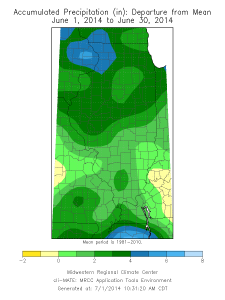Heavy rains fell over Champaign-Urbana, Illinois on Saturday with more rain early Sunday morning. The two-day total through Sunday morning was 4.42 inches at the official NWS COOP station at the Illinois State Water Survey near the corner of First and Windsor in Champaign. Here is the breakdown by day, with the official observation time at 8 am:
- 0.09 inches of rain by 8 am July 12
- 4.33 inches of rain by 8 am July 13
The 4.33 inches for July 13, 2014, at the official, long-term site for Champaign-Urbana, falls short of the historical record 1-day total, which is 5.32 inches of rain from August 12, 1993.
Here are the reports from the CoCoRaHS network for Champaign-Urbana, showing two reports of over 5 inches, and several reports of between 4 and 5 inches.
Here is a wider view showing the rains of the last two days from a NWS product that combines radar and rain gage information. The amounts of 2.5 to 4 inches stretches from Chicago down to east-central Illinois with the heaviest amounts of possibly up to 6 inches in Champaign, Piatt, McLean, and Ford counties.






